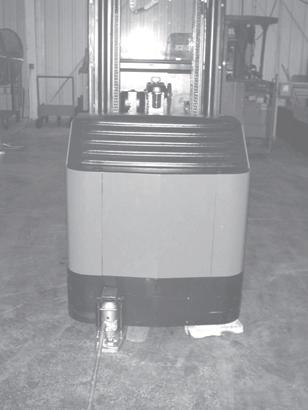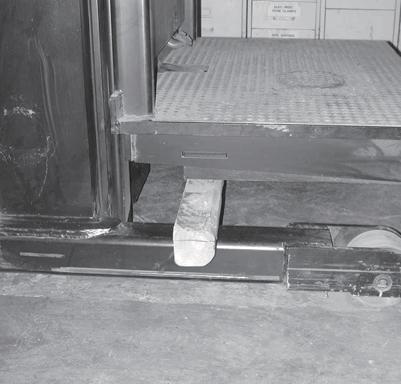
4 minute read
Height, Upright Lowered 95 inch (2413 mm
Jacking Truck Off The Floor
To perform maintenance that requires the truck to be lifted from the floor, observe the proper safety precautions as follows:
1.Lower forks completely. Remove any load. 2.Place all controls in neutral. 3.Block wheels to reduce risk of truck movement. 4.Disconnect battery connector from the truck. 5.Place the jack under the designated jacking points.
WARNING Use extreme care whenever the truck is jacked up for any reason. Never block the truck between the mast column and floor. Use a suitable hoist to stabilize the mast. Keep hands and feet clear from beneath the truck while jacking. Use safety stands or solid blocks to support the truck. Do not rely on the safety stands or blocks alone to support the truck.
Operator Platform
1.Using the lift button, raise the operator platform to obtain sufficient clearance. 2.Place a stand or block between the platform and a baseleg and carefully lower the platform onto the safety stand. 3.Turn key switch OFF and depress emergency power off (EPO) switch. Disconnect battery connector from truck.
Example
Block
Group 01, Periodic Service
Truck Frame
1.Place the jack at the designated jacking point to one side of the truck frame. 2.Jack one side of the truck frame so the drive wheel is off the floor approximately 1 inch (25.4 mm). Block that side of the truck in place. 3.Jack up the other side of the truck frame level with the first side. 4.Block that side of the truck in place. 5.With the truck frame securely blocked with the drive tire off the floor, functional tests may be performed to verify truck operation.
Example
Tractor Jacking Points
Baseleg
1.Place the jack at the designated jacking point. 2.Jack the baseleg until sufficient clearance to replace the load wheel.
Example

SM 844

Baseleg
Operator Platform Blocking Point
Baseleg Jacking Points
01-1-2
Group 01, Periodic Service
Lubricants
Standard
The recommended ambient temperature is above 40° F (5° C) for a truck in its standard design under continuous operation. Truck operation should apply to the following guidelines:
• Parked outside storage area when not in use • Charging and maintenance work to be done outside storage
Cold Storage
To reduce moisture contamination in the electrical system, a truck equipped with cold storage conditioning packages have electrical compound applied to all electrical connections during assembly. For a cold storage truck with continuous operation, the recommended ambient temperature is to 14° F (-10° C). Truck operation should apply to the following guidelines: • Truck completely dry prior to commencing the continuous stay in the cold storage • Parked inside the cold storage for operator • breaks • Charging and maintenance work done outside the cold storage • Truck completely dry before returning to continuous cold storage operation
For a cold storage truck with intermittent operation, the recommended ambient temperature is to -4° F (-20° C). Truck operation should apply to the following guidelines: • Surface condensation occurs, “wet” truck should neither remain idle in the cold storage for no longer than 10 minutes nor operate inside the cold storage for extended periods • Condensation must not be allowed to freeze on the truck at any time • Park outside the cold storage for operator breaks • Charging and maintenance work to be done outside the cold storage
Items included in the cold storage package are as follows: • In an environment where a damp, wet, or corrosive condition exists the following guidelines apply: − All hardware coated with LPS Rust Inhibitor during and/or after assembly − Sealed components (switches, push/pull cables, sensors, etc.) where appropriate
− Grease fittings provided on axle and other pivot points − Plated pins, shafts and linkage where required − All electrical connections coated with Dow Corning No. 4 compound during assembly − Lift chains coated with Libriplate chain protectant − Components coated with LPS Cold Galvanize where appropriate − Components (adjustable features, bearing races, etc.) coated with Antiseize where appropriate • Sealed components used in all non-heated • locations • Heavy-duty mechanical switches used where appropriate • Thermostat controlled heaters used to reduce moisture buildup in electrical component areas • Heaters located around the electronic card, the drive and controller, the steering tachometer, and hydraulic control potentiometers • Windshield replaced with a screen • Hydraulic fluid in lift system changed to 1802154 • Standard grease replaced with Mystik JT-6 lubricating grease
SM 844 Freezer
To reduce moisture contamination in the electrical system, a truck equipped with freezer storage conditioning packages have electrical compound applied to all electrical connections during assembly. For a freezer storage truck with continuous operation, freezer temperature must remain above -20° F (- 29° C). Truck operation should apply to the following guidelines: • Truck must be parked inside the freezer for operator breaks • Truck stays in the freezer during battery charging or change-out (If truck is removed from freezer for maintenance work or battery charging, it must be completely dry before reentering the continuous shift in the freezer.)
Items included in the freezer storage package are as follows:
• All cold storage items • Transmission fluid in the lift system will be changed to Valvoline Heavy Duty Synthetic 80W90


